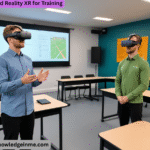Voice Activated Technology It relies on automatic speech recognition (ASR) and natural language processing (NLP) to understand and execute tasks. Here’s a breakdown of its key aspects:
Key Applications of Voice-Activated Technology
- Virtual Assistants – Siri (Apple), Google Assistant, Alexa (Amazon), Cortana (Microsoft).
- Smart Home Devices – Voice-controlled lights, thermostats, security systems (e.g., Google Nest, Amazon Echo).
- Automotive Systems – Hands-free navigation, calls, and media control (e.g., Apple Car Play, Android Auto).
- Healthcare – Voice-to-text dictation for medical notes, assistive tech for people with disabilities.
- Customer Service – AI-powered voice bots for call centers (e.g., IVR systems, chatbots).
- Accessibility Tools – Voice commands for users with mobility or vision impairments.
How It Works
- Voice Capture – A microphone picks up the user’s speech.
- Speech Recognition – Converts spoken words into text using ASR.
- Action Execution – The system responds by performing the requested task (e.g., playing music, answering a query).
Challenges & Considerations
- Accuracy – Background noise, accents, and dialects can affect recognition.
- Privacy Concerns – Always-on devices may raise data security issues.
- Limited Context Understanding – Some systems struggle with complex or multi-step commands.
Core Technologies Behind Voice Activation
- Voice-activated systems rely on a combination of cutting-edge technologies:
- Automatic Speech Recognition (ASR) – Converts spoken words into text (e.g., Open AI Whisper, Google Speech-to-Text).
- Natural Language Processing (NLP) – Understands context, intent, and semantics (e.g., BERT, GPT-4o).
- Machine Learning (ML) – Improves accuracy by learning from user interactions.
- Text-to-Speech (TTS) – Generates human-like responses (e.g., Amazon Polly, Google Wave Net).
Advanced Applications Beyond Basic Commands
Voice tech is evolving beyond simple tasks:
- Voice Commerce (V-Commerce) – Shopping via voice (e.g., Alexa ordering products).
- Emotion Detection – AI analyzes tone to gauge user mood (used in customer service).
- Multilingual & Code-Switching Support – Handles mixed-language commands (e.g., Spanglish).
- Voice Cloning – Replicates a person’s voice for personalized assistants (e.g., Open AI’s Voice Engine).
- Voice-Controlled Robotics – Industrial robots or drones operated via speech.
Privacy & Security Challenges
- Eavesdropping Risks – Always-listening devices may accidentally record private conversations.
- Data Storage – Where is voice data stored? (e.g., Amazon Alexa saves recordings by default).
- Voice Spoofing – Hackers can mimic voices for fraud (e.g., deep fake voice scams).
- Regulations – GDPR (EU) and CCPA (California) impose strict rules on voice data usage.
How to Protect Yourself
- Disable always-listening modes when not needed.
- Regularly delete voice history (e.g., Google Assistant, Alexa app).
- Use voice authentication for sensitive actions (e.g., banking).
Future Trends & Innovations
- Zero-Interaction Voice Tech – Predicts needs without wake words (e.g., AI anticipating commands).
- Offline Voice Assistants – Privacy-focused local processing (e.g., Mycroft, Rhasspy).
- Brain-Computer Interfaces (BCI) – Elon Musk’s NEURA link explores “thinking” commands.
- Voice in AR/VR – Meta and Apple Vision Pro integrate voice for immersive control.
- Healthcare Diagnostics – Detecting illnesses (e.g., Parkinson’s) via voice patterns.
Choosing the Right Voice-Activated Device
Use Case Best Device
Smart Home Control Amazon Echo (Alexa), Google Nest Hub
Privacy-Focused Apple Home Pod (Siri, on-device processing)
Business/Productivity Microsoft Cortana, Dragon NaturallySpeaking
Accessibility Voice ITT (for speech impairments), Talk ITT
Automotive Apple Car Play, Android Auto, BMW’s Voice Assistant
Developer Tools to Build Voice Apps
- Amazon Lex – Build Alexa-like chatbots.
- Google Dialog flow – Design conversational AI.
- Microsoft Azure Speech – Add voice to apps.
- Open AI Whisper – Free, open-source speech recognition.
- Rasa – Open-source NLP for custom assistants.
Ethical & Societal Impact
- Bias in Voice AI – Some systems struggle with accents (e.g., African American Vernacular English).
- Job Displacement – Voice bots replacing call center jobs.
- Digital Divide – Elderly or low-tech users may face exclusion.
Under the Hood: How Voice AI Really Works
Signal Processing Pipeline
- Acoustic Beamforming – Smart microphones (like in Echo devices) use multiple mics to isolate your voice from background noise.
- Feature Extraction – Converts raw audio into Mel-Frequency Cepstral Coefficients (MFCCs) or spectrograms for ML models.
- End-to-End Deep Learning – Modern systems (e.g., Open AI’s Whisper) skip traditional steps and map audio directly to text using transformers.
Wake Word Engineering
- Custom wake words require tiny ML models (e.g., Tensor Flow Lite) to run locally on low-power chips.
- False trigger mitigation: Devices use “negative examples” (e.g., sounds similar to “Alexa”) to reduce accidental activations.
Cutting Edge Research & Unreleased Tech
Experimental Concepts
- Silent Speech Interfaces – NASA experiments with subvocal recognition (reading muscle movements in your throat when you “think” words).
- Ultrasound Voice Sensing – Detects tongue/lip movements through soundwaves (no microphone needed).
- Quantum Speech Recognition – Theoretical use of quantum computing to process speech exponentially faster (IBM/Qiskit research).
Leaked Prototypes
- Google “Project Ellmann” – AI that uses voice + camera to predict user needs (e.g., “You usually make coffee now—turn on the kettle?”).
- Apple’s “On-Device GPT” – Rumored Siri overhaul running LLMs locally on iPhones for privacy.
Niche & Bizarre Use Cases
- Voice-Powered Plant Care – “Talking” to plants with sensors that trigger watering (Japan’s “Green Voice” experiment).
- Vocal Biomarkers – Startups like SONDE Health detect depression or COVID-19 from subtle voice changes.
- Archaeology of Speech – AI reconstructing dead languages or historical accents (e.g., Shakespearean English).
- Voice NFTs – Celebrities selling digital voice clones as collectibles (e.g., Snoop Dogg’s voice pack).
Hardware Deep Dive: Chips & Sensors
Component Function Example Tech
Always-On DSP Low-power wake word detection Qualcomm Hexagon, Apple Neural Engine
Far-Field Microphones 360° voice pickup Amazon Echo’s 7-mic array
Neuromorphic Chips Brain-inspired voice processing Intel Loihi 2
Lidar for Lip Reading Enhances accuracy in noisy spaces Apple iPad Pro’s lidar + voice combo
The Dark Side: Hacking & Exploits
Real-World Attacks
- Dolphin Attack – Ultrasonic voice commands (inaudible to humans) that trick devices (e.g., “Open PayPal” at 20kHz).
- Laser Microphone Injection – Shining a laser on a device’s mic diaphragm to inject fake commands (University of Michigan research).
- Adversarial Audio – Hidden voice commands (e.g., saying “OK Google” in white noise that sounds like static to humans).
Defenses
- Liveness Detection – Checking for human breath patterns or lip sync (used in banking voice AUTH).
- RFID Jamming – Blocking ultrasonic attacks with signal jammers.
The Next Decade: Sci-Fi Becomes Reality
- Brain-to-Voice Synthesis – Implants that let paralyzed patients speak through AI (e.g., UC San Francisco’s neuroprosthesis).
- Ambient Computing – No wake words needed; AI infers intent from context (e.g., Google’s “The Ambient Future” project).
DIY & Underground Projects
- Jasper (Open-Source Alexa Alternative) – Raspberry Pi-based voice assistant with full local control.
- Vosk-API – Offline speech recognition for privacy hackers.
- Voice Hacking Kits – Tools like Silent Sub to experiment with ultrasonic voice attacks.





